1900s
Throwing Animals for Taking Death Leaps
Circus proprietor Edward Wulff patented a curious device in 1904. It was an apparatus that catapulted animals upwards. It had the rather alarming title, "Throwing Animals For Taking Death Leaps" (Patent No. 774,017). Wulff claimed it could throw "horses, elephants, monkeys, &c.." The patent illustration shows a horse, so these were evidently the primary animal being thrown.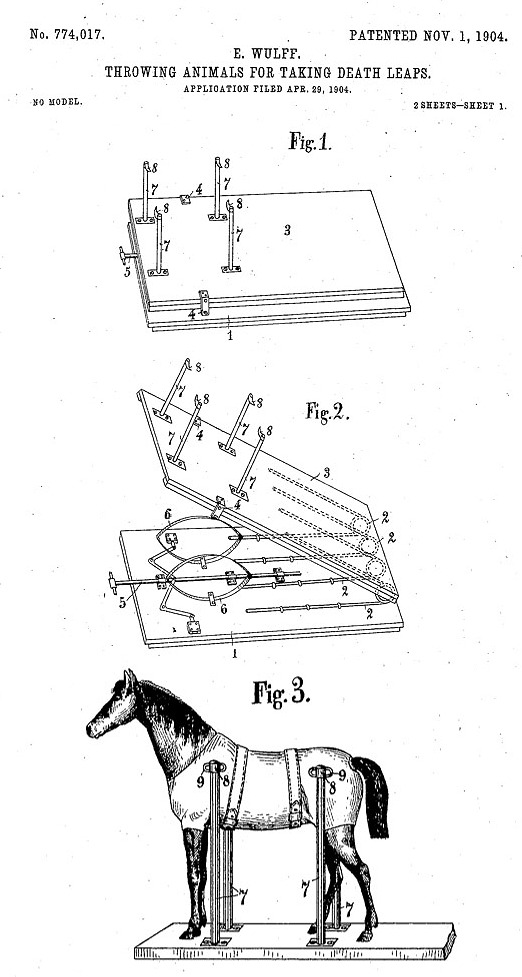
The device was relatively straight-forward. The animals were placed in a harness that held them on top of a spring-powered platform. The release of the springs then flung the animals upwards. Wulff emphasized that his apparatus was designed, via the harness, to place the projecting force on the full body of the animal, rather than just their legs. He seemed to feel that this was a safer, more humane method of throwing animals.
Wulff explained that this device was designed to be used as part of a circus stunt known as "a death leap or so-called 'salto-mortale.'" But he didn't offer any further explanation about the nature of the stunt or how far the animals were flung. And I couldn't locate any descriptions of this stunt in other sources. All the references to a 'death leap' stunt that I came across involved human trapeze artists, not animals. So I was about to conclude that the stunt would have to remain a mystery until I got the idea to check if Wulff had filed the patent in any other countries. Sure enough, there was a British version of the patent, and while its text was almost identical, it had a different title that explained the nature of the stunt:
So Wullf's apparatus was evidently designed to somersault animals. Not simply to catapult them upwards. This made me recall something I posted here on WU back in 2012. It was a brief item that appeared on the front page of the Washington Post's 'Miscellany Section' on April 21, 1907, titled 'Horse Can Turn Somersaults.' At the time, this random reference to a somersaulting horse totally baffled me. I even suspected it was a hoax. But now it makes sense. It must have been a circus stunt. Perhaps it even made use of Wulff's invention. I can't find any evidence that Wulff's circus was in Boston in April 1907, but it was in New York in December of that year.
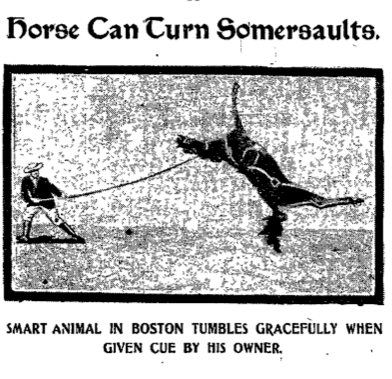
Wulff, it turns out, was the author of another odd patent, granted to him in 1887. The patent was titled, "Means and apparatus for propelling and guiding balloons." He intended to use birds such as "eagles, vultures, condors, &c" to guide balloons. The birds would be attached to the balloon by a harness, and an aeronaut would then force them to fly in the desired direction, thereby propelling the balloon.
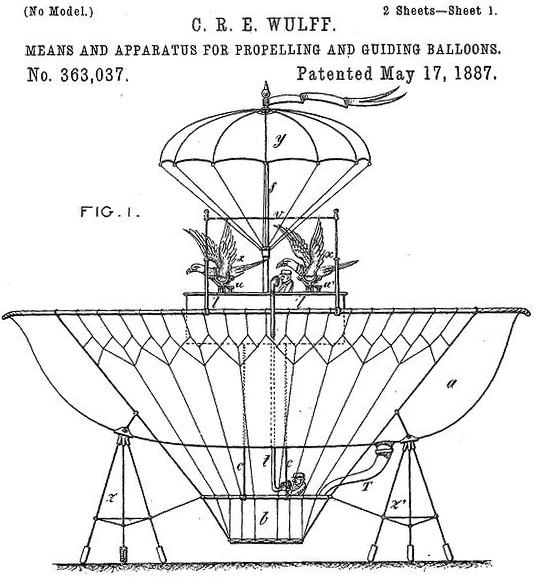
This patent has received quite a bit of attention, because there's a lot of interest in the history of early attempts at flying machines. Knowing that Wulff was a circus proprietor, I wonder if he intended his eagle-guided balloon to be used as part of a circus act, rather than as a practical flying machine.
Posted By: Alex - Sun Feb 09, 2020 -
Comments (6)
Category: Animals, Inventions, Patents, ShowBiz, 1900s
The Artist’s Dilemma
This pretty much encapsulates my average workday.
Posted By: Paul - Sat Jan 04, 2020 -
Comments (0)
Category: Art, Surrealism, Movies, Special Effects, 1900s
The Frank Landslide
The Wikipedia page.
Posted By: Paul - Sun Oct 20, 2019 -
Comments (1)
Category: Death, Destruction, Disasters, Nature, 1900s, North America
The Dream of a Rarebit Fiend
Posted By: Paul - Tue Oct 15, 2019 -
Comments (2)
Category: Dreams and Nightmares, Movies, Special Effects, Surrealism, 1900s
1904 Baby Parade
Children should be forced to do this nowadays.
Posted By: Paul - Sat Aug 24, 2019 -
Comments (3)
Category: Parades and Festivals, Babies and Toddlers, Children, 1900s
Follies of the Madmen #439

No cereal that has touched dirty baby butt is going in my dish!
Source.
Posted By: Paul - Tue Aug 13, 2019 -
Comments (4)
Category: Babies, Business, Advertising, Food, Hygiene, 1900s
Big Boot Dance
The performer is. Harry Relph, aka Little Tich. The performance was filmed at the 1900 Paris Exposition.More info: wikipedia
Posted By: Alex - Sun Aug 04, 2019 -
Comments (2)
Category: ShowBiz, Theater and Stage, Vaudeville, Shoes, 1900s
Decapitation Experiment
Weird science: How long does a severed head remain conscious? In 1905, Dr Gabriel Beaurieux used the opportunity of the execution of the criminal Henri Languille by guillotine to attempt to find out. From a contemporary newspaper account of the scene:"Languille! Languille!"
Terrible stillness for a moment. And, look! The dead head actually obeys! The eyelids open, and two eyes, abundant with life, glare questioning at Dr. Beaurieux—and then the lids close.
But the doctor has no mercy—he is experimenting. And once more he commands:
"Languille!"
Again the eyelids open, and two soulless eyes attempt to see, to find a point in the space. A conscious struggle really is proceeding, until the lids again close. But for the third time Dr. Beaurieux raises the head up in the air:
"Languille!"
This time in vain. The experiment had lasted thirty seconds, and now the question is:
Has the reflecting movement released other functions of the brain? Did Languille know that they called him, and that he had better awaken and answer? Gruesome it were, if he really had answered, for instance repeated his "Goodbye, you beautiful life!"

The execution of Henri Languille - source: wikipedia

The Racine Journal Times - Aug 23, 1905
Posted By: Alex - Thu May 16, 2019 -
Comments (5)
Category: Death, Science, Experiments, 1900s
Happy April Fool’s Day 2019
Jokes were more gruesome in 1909.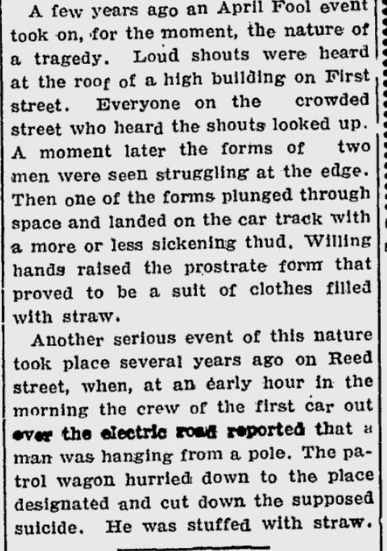
Source.
Posted By: Paul - Mon Apr 01, 2019 -
Comments (4)
Category: Customs, Death, Hoaxes and Imposters and Imitators, Holidays, Humor, 1900s
The Advertising Chair
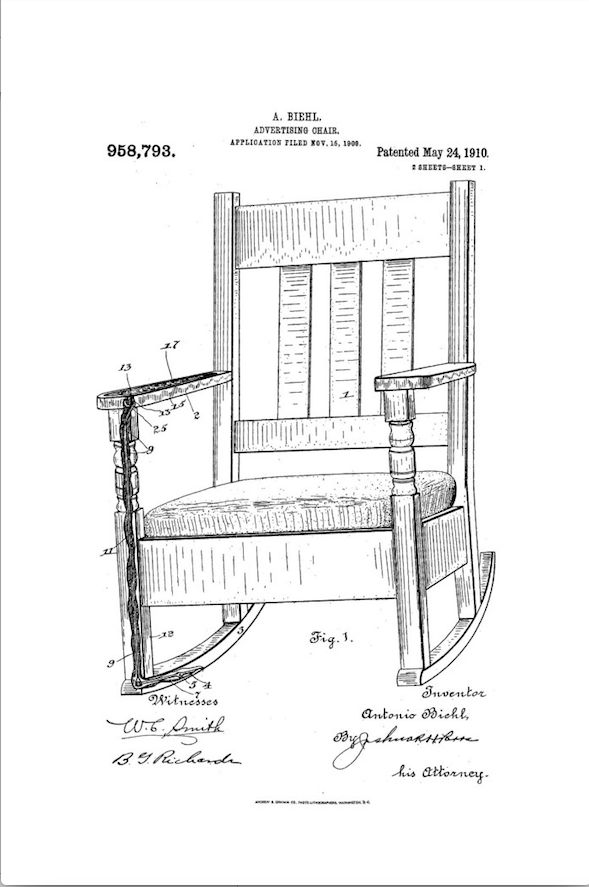
When the chair rocked, visible adverts scrolled in the arms of the chair. So much for our age having a monopoly on intrusive ads.
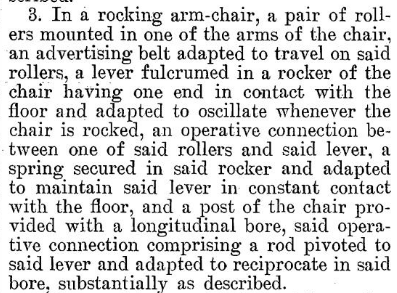
Complete patent here.
Posted By: Paul - Wed Sep 12, 2018 -
Comments (0)
Category: Inventions, Patents, Technology, Advertising, Interior Decorating, 1900s

| Who We Are |
|---|
| Alex Boese Alex is the creator and curator of the Museum of Hoaxes. He's also the author of various weird, non-fiction, science-themed books such as Elephants on Acid and Psychedelic Apes. Paul Di Filippo Paul has been paid to put weird ideas into fictional form for over thirty years, in his career as a noted science fiction writer. He has recently begun blogging on many curious topics with three fellow writers at The Inferior 4+1. Contact Us |




